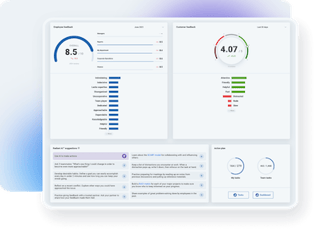
How to Make 360-Degree Feedback Truly 360: 4 Gaps to Fix for Better Results
360-degree feedback is a trusted way to help employees grow, support better coaching, and improve teamwork. It gives people a full view of their strengths and opportunities by gathering input from the coworkers who know their work best. But as work has become more cross-functional and hybrid, many 360 programs have not kept up. The result is feedback that is called 360, but does not capture the full circle.
This article explains what 360-degree feedback is, why it is popular, the most common pitfalls in traditional programs, and four specific gaps that keep many processes from being truly comprehensive. You will also learn practical ways to close those gaps and how modern tools make the process faster and easier.
What is 360-degree feedback and why does it matter?
360-degree feedback gathers confidential input from an employee’s manager, peers, and direct reports. Some teams also include partners or customers. The goal is to provide a complete view of how someone leads, collaborates, and communicates across the organization. When employees see how their behavior impacts others, they can build on strengths and address blind spots.
Organizations keep using 360 feedback because it:
- Brings a broader perspective: Employees see how their work lands with different groups that interact with them.
- Supports clear development: Strengths and growth areas become easier to target with realistic goals and coaching.
- Builds a better culture: Regular feedback encourages continuous improvement and shared expectations.
If you want a step-by-step overview of setting up or improving your program, see our 360-degree reviews guide for employee development: https://www.macorva.com/blog/360-degree-reviews-a-practical-guide-to-improving-employee-development
Common pitfalls in traditional 360-degree feedback programs
Many 360 processes were built for simpler, more hierarchical organizations. Today’s work is faster, more networked, and often remote or hybrid. As a result, several common pitfalls can limit the value of your feedback program:
- Limited perspectives: Small, hand-picked rater groups can miss important voices and introduce bias.
- Resource drain: Manual cycles require heavy coordination and often result in long, underused reports.
- Lack of follow-through: Feedback that isn’t tied to action plans or regular check-ins rarely leads to real change.
- One-time events: Annual reviews don’t reflect the pace of modern work or provide timely insights.

To deliver on the promise of 360 feedback, programs must evolve to reflect how people actually work and interact.
Gap 1: Limited manager perspectives
Most 360 models allow only one manager to rate an employee, usually the direct supervisor. While this is a critical perspective, it leaves out valuable feedback from other leaders—such as department heads, senior leaders, or managers from other teams and projects who have worked with the employee. Without these additional viewpoints, employees may miss out on recognition and guidance from leaders who see different aspects of their work. Manager relationships play a big role in employee engagement, and feedback from a broader range of leaders helps create a more balanced and accurate review. It also shows employees that their contributions are visible across the organization.
Include leadership beyond the direct manager
- Invite input from department heads, senior leaders, or managers from other teams who have observed the employee’s work.
- Include project and program managers who collaborated with the employee during the review period.
- Keep requests brief and focused to encourage participation.
Expanding the manager pool ensures employees receive well-rounded feedback and helps strengthen their connection to leadership across the organization.
Gap 2: Narrow peer feedback
Raters are often limited to peers in the same immediate team, which ignores peers from other departments, project collaborators, mentors, and coaches who know the work well. In today’s workplace, people contribute across teams, time zones, and systems. Limiting peer input to a single group misses major parts of the job. Peers who are familiar with an employee’s work can share specific examples of collaboration, quality, and communication. Including cross-functional peers also helps reduce blind spots that can happen inside a single team.

Bring in cross-functional peers and mentors
- Invite peers from any function who collaborated with the employee in the last period, including remote partners and project teammates.
- Add mentors and coaches who can speak to skill growth and behavior change.
- Use short, mobile-first surveys with simple ratings and one small comment box. This helps more peers participate without delay.
Expanding peer feedback not only gives a more accurate picture of performance, but also creates more opportunities for employee recognition. When employees are recognized by a wide range of colleagues, it boosts engagement and helps foster a culture of appreciation. If you want to learn more about how 360-degree feedback can elevate your recognition program and help you identify standout employees, download our Mastering Employee Recognition with 360-Degree Feedback eBook. This resource covers how to use feedback for recognition, steps to build a motivating program, and best practices for fostering a culture of feedback and appreciation.
Gap 3: Overlooking informal and indirect reports
Traditional 360s focus on formal direct reports. They skip people who take day-to-day guidance from the employee, like indirect reports, mentees, and temporary project teammates. These relationships show how someone supports and enables others, even without a management title. Including these voices helps you spot employees who already coach, onboard, and coordinate work. It also shows how teammates experience clarity, support, and follow-through when working with the person.
Capture influence without a title
- Ask for input from mentees, indirect reports, and project teammates who received guidance.
- Use targeted questions about clarity, listening, and support to capture this impact.
- Keep responses anonymous and only show results for safe group sizes so people feel comfortable sharing.
Recognizing informal leadership and influence helps organizations identify and develop talent that might otherwise go unnoticed.
Gap 4: Static, qualitative feedback that is hard to act on
Once-a-year, comment-heavy surveys create long reports that are not easy to compare over time. With a few raters and mostly open text, it is tough to find patterns or measure progress. Employees need timely input and clear signals on what to do next. Leaders need simple, repeatable ways to track outcomes and coach to specific behaviors. Opening up 360s to more raters, collected more often, and using at-a-glance metrics makes feedback more dynamic, measurable, and actionable.

Make feedback measurable and ongoing
- Collect feedback more often in smaller pulses with simple rating scales and a brief comment.
- Turn responses into trend charts and benchmarks that employees and managers can review together.
- Follow each cycle with one or two clear actions and a quick check-in to keep momentum.
Shifting to frequent, measurable feedback makes it easier for employees and managers to track progress and turn insights into real development.
Building engagement and growth with modern 360 feedback
Modern 360 feedback goes beyond annual reviews and static reports. When feedback is ongoing and includes input from all directions, employees gain a clear view of their strengths, progress, and opportunities for growth. Managers have access to timely, actionable data that makes coaching more effective and focused. This shared understanding helps teams recognize achievements, address challenges early, and build a culture of trust and accountability. With the right tools, 360 feedback becomes a continuous driver of engagement and development across the organization.
How Macorva supports a modern 360 program
Macorva EX streamlines every step of the 360 feedback process. Surveys are easy to create and automate, so feedback can be collected from anyone in the organization, across teams, projects, and reporting lines. Employees can quickly rate coworkers using short, mobile-friendly surveys, and responses remain fully anonymous to encourage honest input.
Once feedback is gathered, Macorva’s AI analyzes both scores and comments, surfaces key themes, and benchmarks results. The platform turns this data into clear, actionable insights that help managers and employees spot trends, recognize strengths, and address growth areas. With Macorva, 360 feedback becomes an ongoing, automated process that delivers real value for development and performance.
Learn more about our AI-powered employee experience and 360 feedback platform.
Frequently asked questions about 360-degree feedback
360-degree feedback is a process where employees receive confidential input from managers, peers, direct reports, and sometimes customers or partners. This multi-source approach provides a well-rounded view of performance and helps identify strengths and areas for development.
To improve a 360-degree feedback program, expand the rater pool to include cross-functional peers and leaders, collect feedback more frequently, use concise surveys, and ensure results are translated into clear, actionable development plans.
The difference between 360-degree feedback and traditional performance reviews is that 360 feedback gathers input from multiple sources, managers, peers, and reports, while traditional reviews typically rely on a single manager’s perspective.
360-degree feedback impacts employee engagement by increasing recognition, providing clarity on strengths and growth areas, and supporting a culture of continuous improvement when feedback is timely and actionable.
Brining 360 feedback full circle
360-degree feedback can give employees a well-rounded view of how they lead, collaborate, and communicate. To maximize impact, include all relevant voices and present results in a format that is easy to use in everyday coaching. When input comes from every direction and turns into simple actions, the program becomes truly 360 and supports lasting growth.
Editors note: this article was originally published in June 2019 and has been updated to reflect new research, employee expectations, and AI-powered 360° feedback tools.





